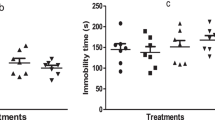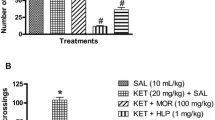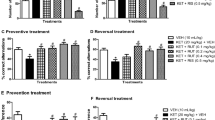Abstract
Schizophrenia is a life disabling, multisystem neuropsychiatric disease mostly derived from complex epigenetic-mediated neurobiological changes causing behavioural deficits. Neurochemical disorganizations, neurotrophic and neuroimmune alterations are some of the challenging neuropathologies proving unabated during psychopharmacology of schizophrenia, further bedeviled by drug-induced metabolic derangements including alteration of amino acids. In first-episode schizophrenia patients, taurine, an essential β-amino acid represses psychotic-symptoms. However, its anti-psychotic-like mechanisms remain incomplete. This study evaluated the ability of taurine to prevent or reverse ketamine-induced experimental psychosis and the underlying neurochemical, neurotrophic and neuroinmune mechanisms involved in taurine’s clinical action. The study consisted of three different experiments with Swiss mice (n = 7). In the drug alone, mice received saline (10 mL/kg/p.o./day), taurine (50 and 100 mg/kg/p.o./day) and risperidone (0.5 mg/kg/p.o./day) for 14 days. In the preventive study of separate cohort, mice were concomitantly given ketamine (20 mg/kg/i.p./day) from days 8 to 14. In the reversal study, mice received ketamine for 14 days before taurine or risperidone treatments from days 8 to 14 respectively. Afterwards, stereotypy behaviour, social, non-spatial memory deficits, and body weights were assessed. Neurochemical (dopamine, 5-hydroxytryptamine, glutamic acid decarboxylase, (GAD)), brain derived-neurotrophic factor (BDNF) and pro-inflammatory cytokines [tumor necrosis factor-alpha, (TNF-α), interleukin-6, (IL-6)] were assayed in the striatum, prefrontal-cortex and hippocampal area. Taurine attenuates ketamine-induced schizophrenia-like behaviour without changes in body weight. Taurine reduced ketamine-induced dopamine and 5-hydroxytryptamine changes, and increased GAD and BDNF levels in the striatum, prefrontal-cortex and hippocampus, suggesting increased GABAergic and neurotrophic transmissions. Taurine decreases ketamine-induced increased in TNF-α and IL-6 concentrations in the striatum, prefrontal-cortex and hippocampus. These findings also suggest that taurine protects against schizophrenia through neurochemical modulations, neurotrophic enhancement, and inhibition of neuropathologic cytokine activities.








Similar content being viewed by others
Data Availability
The datasets generated during and/or analysed during the current study are available from the corresponding author on reasonable request.
Code Availability
Not applicable.
Abbreviations
- KET:
-
Ketamine
- GAD:
-
Glutamic acid decarboxylase
- BDNF:
-
Brain derived-neurotrophic factor
- TNF- α:
-
Tumor necrosis factor alpha
- IL-6:
-
Interleukin-6
- DI:
-
Discrimination index
References
Dietrich-Muszalska A, Kolodziejczyk-Czepas J, Nowak P (2021) Comparative study of the effects of atypical antipsychotic drugs on plasma and urine biomarkers of oxidative stress in schizophrenic patients. Neuropsychiatr Dis Treat 17:555–565. https://doi.org/10.2147/NDT.S283395
Chatterjee M, Verma R, Ganguly S, Palit G (2012) Neurochemical and molecular characterization of ketamine-induced experimental psychosis model in mice. Neuropharmacology 63(6):1161–1171. https://doi.org/10.1016/j.neuropharm.2012.05.041
Howes O, McCutcheon R, Stone J (2015) Glutamate and dopamine in schizophrenia: an update for the 21st century. J Psychopharmacol 29(2):97–115. https://doi.org/10.1177/0269881114563634
Zhang XY et al (2016) Interaction of BDNF with cytokines in chronic schizophrenia. Brain Behav Immun 51:169–175. https://doi.org/10.1016/j.bbi.2015.09.014
Comer AL, Carrier M, Tremblay M-È, Cruz-Martín A (2020) The inflamed brain in schizophrenia: the convergence of genetic and environmental risk factors that lead to uncontrolled neuroinflammation. Front Cell Neurosci 14:274. https://doi.org/10.3389/fncel.2020.00274
Monte AS et al (2013) Prevention and reversal of ketamine-induced schizophrenia related behavior by minocycline in mice: possible involvement of antioxidant and nitrergic pathways. J Psychopharmacol 27(11):1032–1043. https://doi.org/10.1177/0269881113503506
Ben-Azu B, Aderibigbe A, Adeoluwa O, Iwalewa E (2016) Ethanol extracts of Terminalia ivorensis (Chev A.) stem bark attenuates the positive, negative and cognitive symptoms of psychosis in experimental animal models. J Pharm Res Int. https://doi.org/10.9734/BJPR/2016/28629
Ben-Azu B, Aderibigbe AO, Ajayi AM, Eneni A-EO, Umukoro S, Iwalewa EO (2018) Involvement of GABAergic, BDNF and Nox-2 mechanisms in the prevention and reversal of ketamine-induced schizophrenia-like behavior by morin in mice. Brain Res Bull 139:292–306. https://doi.org/10.1016/j.brainresbull.2018.03.006
Ben-Azu B, Aderibigbe AO, Eneni A-EO, Ajayi AM, Umukoro S, Iwalewa EO (2018) Morin attenuates neurochemical changes and increased oxidative/nitrergic stress in brains of mice exposed to ketamine: prevention and reversal of schizophrenia-like symptoms. Neurochem Res 43(9):1745–1755. https://doi.org/10.1007/s11064-018-2590-z
Ben-Azu B et al (2018) Probable mechanisms involved in the antipsychotic-like activity of morin in mice. Biomed Pharmacother 105:1079–1090. https://doi.org/10.1016/j.biopha.2018.06.057
Omeiza NA et al (2022) Pretreatment with Carpolobia lutea ethanol extract prevents schizophrenia-like behavior in mice models of psychosis. J Ethnopharmacol 295:115432. https://doi.org/10.1016/j.jep.2022.115432
Volk DW, Austin MC, Pierri JN, Sampson AR, Lewis DA (2000) Decreased glutamic acid decarboxylase67 messenger RNA expression in a subset of prefrontal cortical gamma-aminobutyric acid neurons in subjects with schizophrenia. Arch Gen Psychiatry 57(3):237–245. https://doi.org/10.1001/archpsyc.57.3.237
Sánchez-Ramón S, Faure F, Jolles S, Leboyer M, Tremblay M-È (2021) Editorial: the crossroads between immunological disorders and neuropsychiatric diseases. A case for schizophrenia. Front Cell Neurosci 15:733997. https://doi.org/10.3389/fncel.2021.733997
Beck K et al (2020) Association of ketamine with psychiatric symptoms and implications for its therapeutic use and for understanding schizophrenia: a systematic review and meta-analysis. JAMA Netw Open 3(5):e204693. https://doi.org/10.1001/jamanetworkopen.2020.4693
Lally J, MacCabe JH (2015) Antipsychotic medication in schizophrenia: a review. Br Med Bull 114(1):169–179. https://doi.org/10.1093/bmb/ldv017
Ramachandraiah CT, Subramaniam N, Tancer M (2009) The story of antipsychotics: past and present. Indian J Psychiatry 51(4):324–326. https://doi.org/10.4103/0019-5545.58304
Wu J-Y et al (2009) Mechanism of neuroprotective function of taurine. Adv Exp Med Biol 643:169–179. https://doi.org/10.1007/978-0-387-75681-3_17
Ommati MM, Heidari R, Ghanbarinejad V, Abdoli N, Niknahad H (2019) Taurine treatment provides neuroprotection in a mouse model of manganism. Biol Trace Elem Res 190(2):384–395. https://doi.org/10.1007/s12011-018-1552-2
Ishola IO et al (2021) Prevention and reversal of ketamine-induced experimental psychosis in mice by the neuroactive flavonoid, hesperidin: the role of oxidative and cholinergic mechanisms. Brain Res Bull 177:239–251. https://doi.org/10.1016/j.brainresbull.2021.10.007
Wu J-Y, Prentice H (2010) Role of taurine in the central nervous system. J Biomed Sci 17(Suppl 1):S1. https://doi.org/10.1186/1423-0127-17-S1-S1
Brand A, Richter-Landsberg C, Leibfritz D (1993) Multinuclear NMR studies on the energy metabolism of glial and neuronal cells. Dev Neurosci 15(3–5):289–298. https://doi.org/10.1159/000111347
Sergeeva OA et al (2003) Taurine-induced long-lasting enhancement of synaptic transmission in mice: role of transporters. J Physiol 550(Pt 3):911. https://doi.org/10.1113/jphysiol.2003.045864
Chen WQ et al (2001) Role of taurine in regulation of intracellular calcium level and neuroprotective function in cultured neurons. J Neurosci Res 66(4):612–619. https://doi.org/10.1002/jnr.10027
O’Donnell CP et al (2016) Adjunctive taurine in first-episode psychosis: a phase 2, double-blind, randomized, placebo-controlled study. J Clin Psychiatry 77(12):e1610–e1617. https://doi.org/10.4088/JCP.15m10185
Yang J et al (2019) Elevated glutamate, glutamine and GABA levels and reduced taurine level in a schizophrenia model using an in vitro proton nuclear magnetic resonance method. Am J Transl Res 11(9):5919–5931
Oyovwi MO, Nwangwa EK, Ben-Azu B, Edesiri TP, Emojevwe V, Igweh JC (2021) Taurine and coenzyme Q10 synergistically prevent and reverse chlorpromazine-induced psycho-neuroendocrine changes and cataleptic behavior in rats. Naunyn Schmiedebergs Arch Pharmacol 394(4):717–734. https://doi.org/10.1007/s00210-020-02003-z
Takatani T et al (2004) Taurine inhibits apoptosis by preventing formation of the Apaf-1/caspase-9 apoptosome. Am J Physiol Cell Physiol 287(4):C949-953. https://doi.org/10.1152/ajpcell.00042.2004
Marcinkiewicz J, Kontny E (2014) Taurine and inflammatory diseases. Amino Acids 46(1):7–20. https://doi.org/10.1007/s00726-012-1361-4
del Olmo N, Bustamante J, del Río RM, Solís JM (2000) Taurine activates GABA(A) but not GABA(B) receptors in rat hippocampal CA1 area. Brain Res 864(2):298–307. https://doi.org/10.1016/s0006-8993(00)02211-3
Bulley S, Shen W (2010) Reciprocal regulation between taurine and glutamate response via Ca2+-dependent pathways in retinal third-order neurons. J Biomed Sci 17(Suppl 1):S5. https://doi.org/10.1186/1423-0127-17-S1-S5
Smith KE, Borden LA, Wang CH, Hartig PR, Branchek TA, Weinshank RL (1992) Cloning and expression of a high affinity taurine transporter from rat brain. Mol Pharmacol 42(4):563–569
Mersman B, Zaidi W, Syed NI, Xu F (2020) Taurine promotes neurite outgrowth and synapse development of both vertebrate and invertebrate central neurons. Front Synaptic Neurosci 12:29. https://doi.org/10.3389/fnsyn.2020.00029
Uchida S, Kwon HM, Yamauchi A, Preston AS, Marumo F, Handler JS (1992) Molecular cloning of the cDNA for an MDCK cell Na(+)- and Cl(-)-dependent taurine transporter that is regulated by hypertonicity. Proc Natl Acad Sci U S A. https://doi.org/10.1073/pnas.89.17.8230
Han X, Patters AB, Jones DP, Zelikovic I, Chesney RW (2006) The taurine transporter: mechanisms of regulation. Acta Physiol (Oxf) 187(1–2):61–73. https://doi.org/10.1111/j.1748-1716.2006.01573.x
Rak K et al (2014) Neurotrophic effects of taurine on spiral ganglion neurons in vitro. NeuroReport 25(16):1250–1254. https://doi.org/10.1097/WNR.0000000000000254
Ben-Azu B et al (2022) Taurine, an essential β-amino acid insulates against ketamine-induced experimental psychosis by enhancement of cholinergic neurotransmission, inhibition of oxidative/nitrergic imbalances, and suppression of COX-2/iNOS immunoreactions in mice. Metab Brain Dis. https://doi.org/10.1007/s11011-022-01075-5
de Araújo FYR et al (2021) Involvement of anti-inflammatory, antioxidant, and BDNF up-regulating properties in the antipsychotic-like effect of the essential oil of Alpinia zerumbet in mice: a comparative study with olanzapine. Metab Brain Dis 36(8):2283–2297. https://doi.org/10.1007/s11011-021-00821-5
Umukoro S, Aluko OM, Eduviere AT, Owoeye O (2016) Evaluation of adaptogenic-like property of methyl jasmonate in mice exposed to unpredictable chronic mild stress. Brain Res Bull 121:105–114. https://doi.org/10.1016/j.brainresbull.2015.11.016
Yu K, Hu S, Huang J, Mei L-H (2011) A high-throughput colorimetric assay to measure the activity of glutamate decarboxylase. Enzyme Microb Technol 49(3):272–276. https://doi.org/10.1016/j.enzmictec.2011.06.007
Schaffer S, Kim HW (2018) Effects and mechanisms of taurine as a therapeutic agent. Biomol Ther (Seoul) 26(3):225–241. https://doi.org/10.4062/biomolther.2017.251
Ghandforoush-Sattari M, Mashayekhi S, Krishna CV, Thompson JP, Routledge PA (2010) Pharmacokinetics of oral taurine in healthy volunteers. J Amino Acids. https://doi.org/10.4061/2010/346237
Rajagopal S, Sangam SR, Singh S, Joginapally VR (2016) Modulatory effects of dietary amino acids on neurodegenerative diseases. Adv Neurobiol 12:401–414. https://doi.org/10.1007/978-3-319-28383-8_22
Tamai I, Senmaru M, Terasaki T, Tsuji A (1995) Na(+)- and Cl(-)-dependent transport of taurine at the blood-brain barrier. Biochem Pharmacol 50(11):1783–1793. https://doi.org/10.1016/0006-2952(95)02046-2
Li X-W, Gao H-Y, Liu J (2017) The role of taurine in improving neural stem cells proliferation and differentiation. Nutr Neurosci 20(7):409–415. https://doi.org/10.1080/1028415X.2016.1152004
Rahmeier FL et al (2016) The effect of taurine and enriched environment on behaviour, memory and hippocampus of diabetic rats. Neurosci Lett 630:84–92. https://doi.org/10.1016/j.neulet.2016.07.032
Burton S (2006) Symptom domains of schizophrenia: the role of atypical antipsychotic agents. J Psychopharmacol 20(6 Suppl):6–19. https://doi.org/10.1177/1359786806071237
Wu G-F et al (2017) Antidepressant effect of taurine in chronic unpredictable mild stress-induced depressive rats. Sci Rep 7(1):4989. https://doi.org/10.1038/s41598-017-05051-3
Newcomer JW, Haupt DW (2006) The metabolic effects of antipsychotic medications. Can J Psychiatry 51(8):480–491. https://doi.org/10.1177/070674370605100803
Haidari F, Asadi M, Mohammadi-Asl J, Ahmadi-Angali K (2020) Effect of weight-loss diet combined with taurine supplementation on body composition and some biochemical markers in obese women: a randomized clinical trial. Amino Acids 52(8):1115–1124. https://doi.org/10.1007/s00726-020-02876-7
Ben-Azu B et al (2019) Morin decreases cortical pyramidal neuron degeneration via inhibition of neuroinflammation in mouse model of schizophrenia. Int Immunopharmacol 70:338–353. https://doi.org/10.1016/j.intimp.2019.02.052
Hashimoto T et al (2003) Gene expression deficits in a subclass of GABA neurons in the prefrontal cortex of subjects with schizophrenia. J Neurosci 23(15):6315–6326
Snyder MA, Gao W-J (2020) NMDA receptor hypofunction for schizophrenia revisited: perspectives from epigenetic mechanisms. Schizophr Res 217:60–70. https://doi.org/10.1016/j.schres.2019.03.010
Merritt K, Egerton A, Kempton MJ, Taylor MJ, McGuire PK (2016) Nature of glutamate alterations in schizophrenia: a meta-analysis of proton magnetic resonance spectroscopy studies. JAMA Psychiat 73(7):665–674. https://doi.org/10.1001/jamapsychiatry.2016.0442
Krebs MO, Gauchy C, Desban M, Glowinski J, Kemel ML (1994) Role of dynorphin and GABA in the inhibitory regulation of NMDA-induced dopamine release in striosome- and matrix-enriched areas of the rat striatum. J Neurosci 14(4):2435–2443
Johnston A, McBain CJ, Fisahn A (2014) 5-Hydroxytryptamine1A receptor-activation hyperpolarizes pyramidal cells and suppresses hippocampal gamma oscillations via Kir3 channel activation. J Physiol 592(19):4187–4199. https://doi.org/10.1113/jphysiol.2014.279083
Paolucci E, Berretta N, Tozzi A, Bernardi G, Mercuri NB (2003) Depression of mGluR-mediated IPSCs by 5-HT in dopamine neurons of the rat substantia nigra pars compacta. Eur J Neurosci 18(10):2743–2750. https://doi.org/10.1111/j.1460-9568.2003.03015.x
Akil M, Edgar CL, Pierri JN, Casali S, Lewis DA (2000) Decreased density of tyrosine hydroxylase-immunoreactive axons in the entorhinal cortex of schizophrenic subjects. Biol Psychiatry 47(5):361–370. https://doi.org/10.1016/s0006-3223(99)00282-6
Slifstein M et al (2015) Deficits in prefrontal cortical and extrastriatal dopamine release in schizophrenia: a positron emission tomographic functional magnetic resonance imaging study. JAMA Psychiat 72(4):316–324. https://doi.org/10.1001/jamapsychiatry.2014.2414
Laruelle M et al (2000) Dopamine and serotonin transporters in patients with schizophrenia: an imaging study with [(123)I]beta-CIT. Biol Psychiatry 47(5):371–379. https://doi.org/10.1016/s0006-3223(99)00257-7
El Idrissi A, Trenkner E (2004) Taurine as a modulator of excitatory and inhibitory neurotransmission. Neurochem Res 29(1):189–197. https://doi.org/10.1023/b:nere.0000010448.17740.6e
Jia F et al (2008) Taurine is a potent activator of extrasynaptic GABA(A) receptors in the thalamus. J Neurosci 28(1):106–115. https://doi.org/10.1523/JNEUROSCI.3996-07.2008
Golubeva AV et al (2017) Microbiota-related changes in bile acid and tryptophan metabolism are associated with gastrointestinal dysfunction in a mouse model of autism. EBioMedicine 24:166–178. https://doi.org/10.1016/j.ebiom.2017.09.020
Baydyuk M, Xu B (2014) BDNF signaling and survival of striatal neurons. Front Cell Neurosci 8:254. https://doi.org/10.3389/fncel.2014.00254
Huo L, Zheng Z, Lu X, Wu F, Ning Y, Zhang XY (2021) Decreased peripheral BDNF levels and cognitive impairment in late-life schizophrenia. Front Psychiatry 12:641278. https://doi.org/10.3389/fpsyt.2021.641278
Momtazmanesh S, Zare-Shahabadi A, Rezaei N (2019) Cytokine alterations in schizophrenia: an updated review. Front Psychiatry 10:892. https://doi.org/10.3389/fpsyt.2019.00892
Vernon AC et al (2015) Longitudinal in vivo maturational changes of metabolites in the prefrontal cortex of rats exposed to polyinosinic-polycytidylic acid in utero. Eur Neuropsychopharmacol 25(12):2210–2220. https://doi.org/10.1016/j.euroneuro.2015.09.022
Winter C et al (2009) Prenatal immune activation leads to multiple changes in basal neurotransmitter levels in the adult brain: implications for brain disorders of neurodevelopmental origin such as schizophrenia. Int J Neuropsychopharmacol 12(4):513–524. https://doi.org/10.1017/S1461145708009206
Surai PF, Earle-Payne K, Kidd MT (2021) Taurine as a natural antioxidant: from direct antioxidant effects to protective action in various toxicological models. Antioxidants. https://doi.org/10.3390/antiox10121876
Acknowledgements
The Authors are very grateful to the technical staff of the Department of Pharmacology, Faculty of Basic Medical Sciences, College of Health Sciences for their technical input during the course of the study. Also, the authors are thankful to the International Brain Research Organization (IBRO)-African Regional Committee (ARC) for the 2019 Bursary Fellowship award for this study.
Funding
Benneth Ben-Azu was supported by an International Brain Research Organization African Regional Committee (IBRO-ARC) 2019 Grant for a Postdoctoral Fellowship on Schizophrenia Research at the University of Victoria, BC Canada.
Author information
Authors and Affiliations
Contributions
BBA, GOA, CIU, KEN and DEA: conceived the study and designed the experimental protocol. BBA, MGO, CBO, ECO, EBW, NLE, UVE and DEA: carried out the experiment. BBA, KCC, MGO, GOA, and AMA: contributed new reagents and analytical tool. BBA, AMA, and KEN: supervised the study. BBA, AMA and BSC: analyzed the data. BBA, BSC and CUI: wrote the manuscript. All authors read and approved the manuscript. All data were generated in-house and no paper mill was used. All authors contributed to this research work and the development of the final manuscript.
Corresponding author
Ethics declarations
Conflict of interest
Authors declare that they have no conflict of interest.
Ethical Approval
All applicable international, national, and/or institutional (Delta State University Animal Care and Use Research Ethics Committee) guidelines for the care and use of animals were followed according to the ethical approval number: REC/FBMS/DELSU/21/94.
Additional information
Publisher's Note
Springer Nature remains neutral with regard to jurisdictional claims in published maps and institutional affiliations.
Rights and permissions
Springer Nature or its licensor (e.g. a society or other partner) holds exclusive rights to this article under a publishing agreement with the author(s) or other rightsholder(s); author self-archiving of the accepted manuscript version of this article is solely governed by the terms of such publishing agreement and applicable law.
About this article
Cite this article
Ben-Azu, B., Uruaka, C.I., Ajayi, A.M. et al. Reversal and Preventive Pleiotropic Mechanisms Involved in the Antipsychotic-Like Effect of Taurine, an Essential β-Amino Acid in Ketamine-Induced Experimental Schizophrenia in Mice. Neurochem Res 48, 816–829 (2023). https://doi.org/10.1007/s11064-022-03808-5
Received:
Revised:
Accepted:
Published:
Issue Date:
DOI: https://doi.org/10.1007/s11064-022-03808-5




